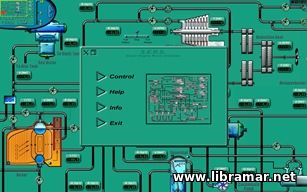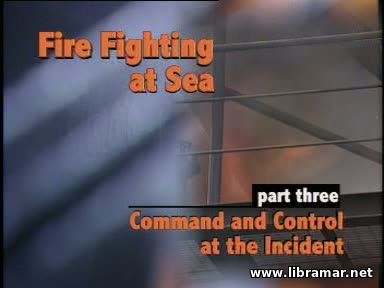Inert Gas System Explained
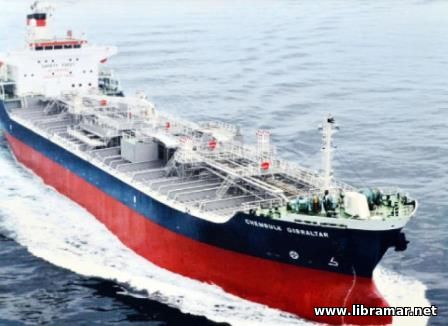
Tankers transport some of the most dangerous flammable cargo that is carried at sea. Yet, what was the last time you have heard of one actually exploding? Sure, you do hear of tankers that have suffered fires and explosion; we also had numerous tankers damaged I the Gulf and other areas. Yes, none of them have truly exploded. We are talking about the sort of explosions we ae seeing with rockets and cars that have been engulfed in flames. In these explosions there is always nothing left. This has happened with ships in the past. In 1976, the tanker “Santa Nina” exploded in Los Angeles. The resultant shockwave literally blew the ship apart and it shattered windows on houses over twenty miles away.
How then do modern tankers carrying thousands of tons of flammable fuel not just exploded in the same way the “Santa Nina” did? To answer that, we need to know a little behind the science of burning hydrocarbons. We all know that burning is just a process of a fuel reacting with oxygen and giving off heat. Obviously, in our case the fuel source we are talking about is the cargo that is carried and the oxygen is in the air. Let’s assume we are just carrying a random hydrocarbon fuel in the tank and it is a liquid at atmospheric pressures and temperatures. The liquid itself does not burn; that is kind of obvious if we think about it. There is no oxygen within the liquid itself – it is only actually the vapors that burn. As fuel evaporates off the surface, it mixes with the oxygen in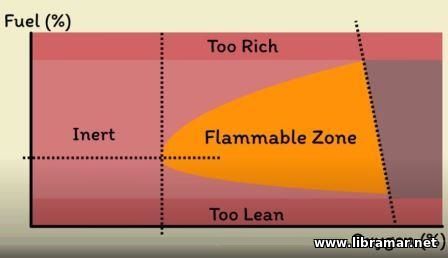 the air and then it just takes a heat source to ignite. The exact proportion of fuel vapor to air needed to catch light does vary, but we can represent that on a flammability diagram.
the air and then it just takes a heat source to ignite. The exact proportion of fuel vapor to air needed to catch light does vary, but we can represent that on a flammability diagram.
There, you can see the percentage of hydrocarbon gas represented on a vertical line and along the bottom we have the percentage of oxygen. If you only have tiny amount of hydrocarbon gas in the air, clearly it is not going to ignite. We say the mixture is too lean; likewise, if you have too much hydrocarbon gas, we say it is too rich. We are left with the area somewhere in the middle of the diagram. So, next we come to the oxygen content. Obviously, normal air has around 21% oxygen, so there is no point going above that because we are not pumping extra oxygen in. you see the dashed line actually sloping a little – that is because the oxygen percentage will naturally decrease when you start mixing in fuel particles.
Finally, at the lower end we have the part of the graph representing a low oxygen level. If the oxygen level is too low, again it is clear that the mixture is not going to ignite. We say the mixture is inert – you do reach a point where the oxygen percentage is just right. If you have the perfect percentage of fuel, then as the oxygen level increases, the range at which the fuel could burn expands. Within the subject area we have the flammable one. If the proportions fall within it, a heat source will ignite the mixture. So, how can we control that?
In a way, the percentage of hydrocarbon is out of our control. It naturally evaporates from the surface of the fuel, so the concentration will vary throughout the tank. The only way we can prevent ignition is to lower the percentage of the oxygen close to the fuel so that it becomes inert. You basically need to add the inert gas – helium, nitrogen, argon, compounds like carbon dioxide – just something will not allow the fuel to burn. Obviously, there are cost implications for the noble gases, so argon and helium are not really a commercially viable option, and leave us with the nitrogen and carbon dioxide option. If you want to go into the expense of generating the gas and containing it, you will probably use nitrogen, as it is in the high percentage in the atmosphere anyway, so it is going to have minimal impact on the cargo in terms of contamination.
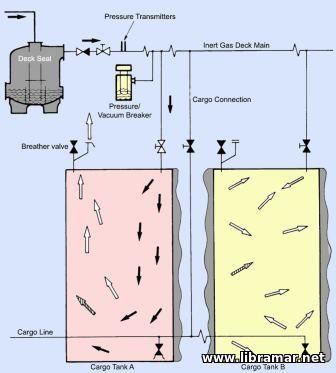 If contamination is not a concern, you can use carbon dioxide and the massive advantage of carbon dioxide is that the ships have carbon dioxide generator already - the main engine producing it as a byproduct of combustion of its own fuel. All we need to do is to clean up the exhaust and we can do that with the inert gas plant. We first pass the flue gas through a scrubbing tower and that cools it down and removes solid contaminants. We then send it through powerful fans that can maintain the same pressure as the cargo tanks – this is to prevent the tanks from buckling if you are emptying them too quick, much like a bottle of water you squeeze to hard. As it crosses the safety barrier into the cargo area, it then passes through some sort of a non-return valve. Commonly, this is a water seal the inert gas can happily bubble through and flow to the tanks, but if flammable vapor from the tanks tries to come out, it creates a water plug, which blocks return to the rest of the ship.
If contamination is not a concern, you can use carbon dioxide and the massive advantage of carbon dioxide is that the ships have carbon dioxide generator already - the main engine producing it as a byproduct of combustion of its own fuel. All we need to do is to clean up the exhaust and we can do that with the inert gas plant. We first pass the flue gas through a scrubbing tower and that cools it down and removes solid contaminants. We then send it through powerful fans that can maintain the same pressure as the cargo tanks – this is to prevent the tanks from buckling if you are emptying them too quick, much like a bottle of water you squeeze to hard. As it crosses the safety barrier into the cargo area, it then passes through some sort of a non-return valve. Commonly, this is a water seal the inert gas can happily bubble through and flow to the tanks, but if flammable vapor from the tanks tries to come out, it creates a water plug, which blocks return to the rest of the ship.
Of course, the system itself is somewhat more complicated than this; we have numerous isolation valves, PV breakers and temperature protection systems. Overall, the system allows us to put the engine exhaust through the cargo tanks, lowering the percentage of oxygen. This plays back into that flammability diagram, bringing the tank atmosphere safely down into the inert area. It is no longer possible for the flammable cargo vapors to ignite and this is why fires and explosions on modern tankers do not result in the same catastrophe that was witnessed in Los Angeles.
The "Read Later" function allows you to add material to this block with just one click. Just click on the icon and read the articles that interest you at any convenient time.
